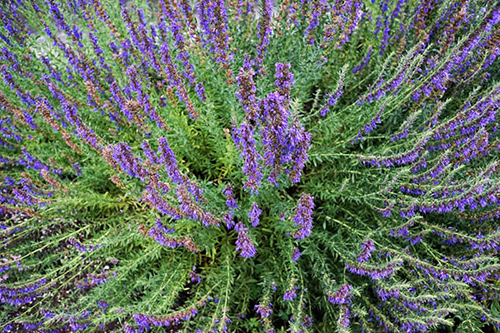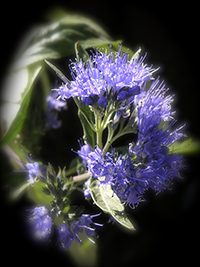Contents
Although the Bible mentions the hyssop plant as a symbol of purity, it is likely to speak about another species since the one we currently know does not grow in Palestine. The great Greek physician, pharmacologist, botanist, and author Pedanius Dioscorides talks about it, and the plant has always been appreciated for its many virtues.

Healing Properties and Warning
The hyssop leaves and flower clusters contain a bitter component called marrubiin, which has mucolytic (which makes the bronchi secretions more fluid) and expectorant properties. This aromatic essence stimulates digestive secretions and has antiseptic properties, as well as several flavonic substances and tannins.
The hyssop plant is recommended for bronchial catarrh, chronic bronchitis, and asthma. It makes the mucous more liquid, preventing its infection and promoting its expulsion. It is also used as a carminative (eliminates the gas from the digestive system), a digestive, and a vermifuge (expels intestinal parasites).
It is used as a vulnerability in external applications (heals wounds and bruises). Gargling with hyssop water renders satisfactory results with tonsilitis.
WARNING! The recommended dose for its essence intake must not be exceeded since it can produce convulsions in high doses.
The hyssop plant is an herb for treating lung conditions like chronic phlegm discharge. It is an excellent expectorant and promotes the expulsion of phlegm and mucus from the respiratory system, thus easing congestion. The plant is also helpful for colds and coughs due to congestion. Hyssop can be used similarly to sage and, at times, combined to create a gargle for sore throat.
The plant is also used for weak digestion, sluggish circulation, and asthma. It helps treat jaundice, dropsy, scrofula, mucus constipation in the intestines, throat, nose congestion, and lung and breast problems; it dispels gas and regulates blood pressure. An infusion taken when warm and combined with equal parts of horehound is an excellent remedy for excess mucus.
An infusion with hyssop alone is an excellent remedy for increasing sweating, especially for breaking a fever. A decoction will aid in relieving inflammation. The herb is also suitable for weight problems, epilepsy, and gout. Externally, it is used to heal wounds. Fresh green hyssop poultices will help heal cuts.
Fomentations made from the leaves can relieve bruises and muscular rheumatism. A wash made from a decoction can be used for skin irritations, scrapes, burns, and gargling for chronic catarrh and sore throat. In some areas, the herb’s decoctions are used as a prescribed gargle for sore throats.
Hyssop plant tea is used to loosen phlegm, treat stomachaches, and relieve gas. Combined with horehound, the tea can treat asthma, coughs, and bronchitis. The plant has been used externally to treat sprains, wounds, muscle aches, and rheumatism. Experiments are being conducted using the extract as an anti-inflammatory to treat herpes simplex.
The plant contains at least eight antiviral compounds. In 1990, researchers discovered that a hyssop extract inhibited the replication of the human immunodeficiency virus (HIV).

Hyssop Plant Scientific Facts

- French: Hysope.
- Spanish: Hisopo.
- Environment: Native to Mediterranean countries, it is grown as an ornamental plant in gardens of Europe and America. Although it is rare, it can be found growing wild on sunny, dry slopes.
- Description: This shrub of the Labiatae family grows from 30 to 60 cm high and has blue or violet flowers in a terminal spike.
- Parts of the plant used medicinally: The leaves and the flower clusters.
How to use Hyssop
- Infusion
- Essence: The recommended dose is from one to three drops daily, three times a day.
- Baths with the same infusion are employed for internal use.
- Gargles with this infusion.
Infusion: Steep for five to fifteen minutes and take one to two cups daily. Tincture: Take ½ to one teaspoon frequently. Fluid Extract: Take one to two teaspoons regularly. Powder: Take ten #0 capsules regularly.
DISCLAIMER: All content on this website is presented solely for educational and informational objectives. Do not rely on the information provided as a replacement for advice, diagnosis, or treatment from a qualified medical expert. If you are pregnant, nursing, or have any preexisting medical concerns, talk to your doctor before using any herbal or natural medicines.
REFERENCES
- George D. Pamplona-Roger, M.D. “Encyclopedia of Medicinal Plants.” George D. Pamplona-Roger, M.D. Encyclopedia of Medicinal Plants. Ed. Francesc X. Gelabert. Vols. 1 San Fernando de Henares: Editorial Safeliz, 2000. 312. Print. [hyssop plant]
- Vance Ferrell Harold M. Cherne, M.D. The Natural Remedies Encyclopedia [Book]. – Altamont, TN: Harvestime Books, 2010. – Vol. Seventh Edition: 7: pp. 164.
- https://www.ncbi.nlm.nih.gov/pmc/articles/PMC6266959/
